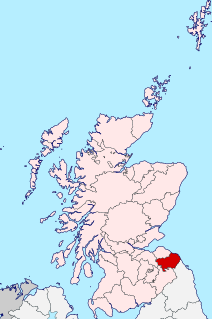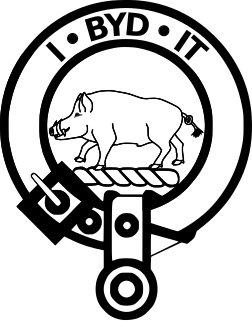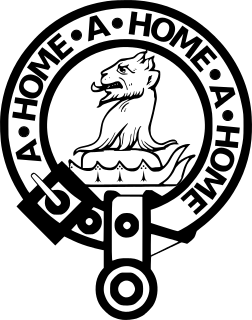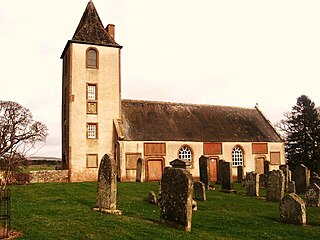
Berwickshire is a historic county, registration county and lieutenancy area in southeastern Scotland, on the English border. It takes its name from Berwick-upon-Tweed, which was part of Scotland at the time of the county's formation, but became part of England in 1482 after several centuries of swapping back and forth between the two kingdoms.

Earl of Home is a title in the Peerage of Scotland. It was created in 1605 for Alexander Home of that Ilk, 6th Lord Home. The Earl of Home holds, among others, the subsidiary titles of Lord Home, and Lord Dunglass (1605), in the Peerage of Scotland; and Baron Douglas, of Douglas in the County of Lanark (1875) in the Peerage of the United Kingdom. Various Earls of Home have also claimed the title of Lord Hume of Berwick. The Earl is also Chief of the Name and Arms of Home and heir general to the House of Douglas. The title Lord Dunglass is the courtesy title of the eldest son of the Earl.

Lord Polwarth, of Polwarth in the County of Berwick, is a title in the Peerage of Scotland. It was created in 1690 for Sir Patrick Hume of Polwarth, 2nd Baronet, Lord Chancellor of Scotland from 1696 to 1702. In 1697 he was further created Lord Polwarth, of Polwarth, Redbraes and Greenlaw, Viscount of Blasonberrie and Earl of Marchmont, also in the Peerage of Scotland. Upon the death of his grandson, the third Earl, the creations of 1697 became dormant (unclaimed).

Marchmont is a mainly residential area of Edinburgh, Scotland. It lies roughly one mile to the south of the Old Town, separated from it by The Meadows and Bruntsfield Links. To the west it is bounded by Bruntsfield; to the south-southwest by Greenhill and then Morningside; to the south-southeast by The Grange; and to the east by Sciennes.

Alexander Hume-Campbell, 2nd Earl of Marchmont, was a Scottish nobleman, politician and judge.

Clan Nesbitt is a Scottish clan of the Scottish Borders that is recognised by the Lord Lyon King of Arms.

The Honourable Adam Robert Bruce is a Scottish solicitor, businessman, and aristocrat who serves as an officer of Arms at the Court of the Lord Lyon.

Patrick Hume, 1st Earl of Marchmont, known as Sir Patrick Hume, 2nd Baronet from 1648 to 1690 and as Lord Polwarth from 1690 to 1697, was a Scottish statesman. His grandfather was the poet and courtier Sir Patrick Hume of Polwarth and Redbraes who died in 1609.

Clan Home is a Scottish clan. It held immense power for much of the Middle Ages and dominated the eastern Scottish Borders. It produced no fewer than eight Wardens of the Eastern March – more than any other family.

Clan Swinton is a Scottish clan of the Scottish Lowlands.

Sir John Helias Finnie McEwen, 1st Baronet or Jock McEwen, was a British Unionist politician who served in the House of Commons as Conservative Member of Parliament for Berwick and Haddington from the 1931 to 1945 general elections.

Clan MacEwen or Clan MacEwan is a Scottish clan recorded in the fifteenth century as Clan Ewen of Otter.

Polwarth is a village and parish in the Scottish Borders area of Scotland. It is located at grid reference NT745502, between Greenlaw and Duns, in the former county of Berwickshire.

Marchmont House lies on the east side of the small village of Greenlaw, and near to a church in Polwarth in Berwickshire, in the Scottish Borders area of Scotland. It is about five miles south west of Duns, about 19 miles (31 km) west of Berwick-upon-Tweed and about 40 miles (64 km) south east of Edinburgh. Situated in a gently undulating landscape, the estate is intersected by Blackadder Water, and its tributary burns. With the Lammermuir Hills to the north and views towards the Cheviot Hills in the south, this part of Berwickshire, sometimes referred to as the Merse, is very scenic and contains rich and fertile agricultural land.

Marchmont Estate lies near the village of Greenlaw in Berwickshire in the Scottish Borders area of Scotland, circa 45 miles (72 km) south east of Edinburgh. It is situated in the Merse, an area between the Lammermuirs to the north and the Cheviots to the south. It is part of what is commonly regarded as an exceptionally beautiful landscape, comprising a diverse range of land types from high and exposed grouse moor to rich alluvial agricultural land. The life of the estate has seen many stages, including rapid growth, shrinkage and stability, from its foundation in the fifteenth century under the first Hume owner, Patrick Hume, of Polwarth, through his successors and subsequent owners to the present day.
The Squadrone Volante or New Party was a political grouping in Scotland which emerged around 1700 as an offshoot of the opposition Country Party. Led by John Ker, 5th Earl of Roxburghe and John Hay, 2nd Marquess of Tweeddale, the party was influential in passing the Act of Union with England in 1707.
The Honourable Alexander Hume-Campbell KC, of Birghamsheil, Berwickshire, was a Scottish lawyer and politician who sat in the House of Commons almost continuously from 1734 to 1760.
Sir Patrick Hume of Polwarth and Redbraes was a Scottish courtier and makar.

Bonkyll Castle was a medieval fortress situated in the historic Scottish county of Berwickshire, from 1973 the Scottish Borders. It is situated 4 miles north of Duns and 4 miles south of Grantshouse. Few traces survive and the site is protected as a scheduled monument. It was the seat of a junior branch of the Stewart family, known as "Stewart of Bonkyl", from which was descended in another junior branch "Stewart of Darnley", the paternal family of King James I & VI of Scotland and England.
Sir John Paterson, 3rd Baronet was a British politician who sat in the House of Commons in 1779 and 1780.















